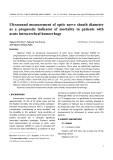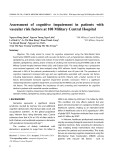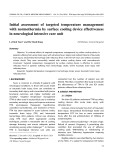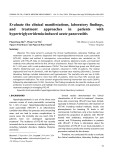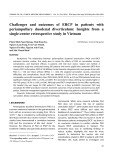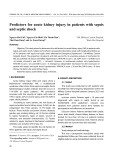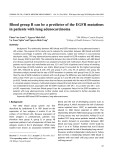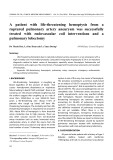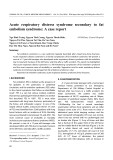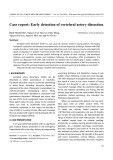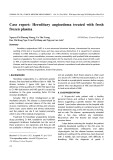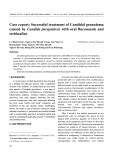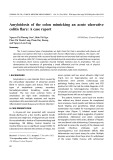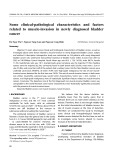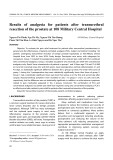M I N I R E V I E W
Post-ischemic brain damage: effect of ischemic preconditioning and postconditioning and identification of potential candidates for stroke therapy Giuseppe Pignataro, Antonella Scorziello, Gianfranco Di Renzo and Lucio Annunziato
Division of Pharmacology, Department of Neuroscience, School of Medicine, ‘‘Federico II’’ University of Naples, Italy
Keywords cerebral ischemia; ionic homeostasis; kinase; MnSOD; neuroprotection; nitric oxide; postconditioning; preconditioning; stroke; tolerance
the brain from a subsequent
Correspondence L. Annunziato, Division of Pharmacology, Department of Neuroscience, School of Medicine, ‘‘Federico II’’ University of Naples, Naples, Italy Fax: +39 081 7463323 Tel: +39 081 7463318 E-mail: lannunzi@unina.it
(Received 30 July 2008, revised 4 September 2008, accepted 13 October 2008)
Because clinical trials of pharmacological neuroprotective strategies in stroke have been disappointing, attention has turned to the brain’s own endogenous strategies for neuroprotection. Two endogenous mechanisms have been characterized so far, namely ischemic preconditioning and ische- mic postconditioning. The neuroprotective concept of preconditioning is based on the observation that a brief, noninjurious episode of ischemia is longer ischemic insult. able to protect Recently, a hypothesis has been offered that modified reperfusion subse- quent to a prolonged ischemic episode may also confer ischemic neuro- protection, a phenomenon termed postconditioning. Many pathways have been proposed as plausible mechanisms to explain the neuroprotection offered by preconditioning and postconditioning. Unfortunately, so far, none of them has clearly identified the mechanism involved in precondi- tioning and postconditioning. The present article will review the main mechanisms reported to date to explain the neuroprotective effect of both ischemic preconditioning and postconditioning.
doi:10.1111/j.1742-4658.2008.06769.x
Stroke is the third most common cause of death after heart attack and cancer and has profound negative social and economic effects. The failure, over the past three decades, of multiple clinical trials of exogenously administered drugs as potential stroke neuroprotec- tants has enhanced the ongoing search to identify endogenously modulated mechanisms activated after cerebral ischemia that might be harnessed as neuropro- tectants in stroke [1–3]. Such molecular mechanisms might be those evolutionarily conserved to counteract the damage induced by a disruption to the cerebral blood supply [4].
In this attempt, ischemic preconditioning and ische- mic postconditioning represent two promising strategies in modulating ischemic damage. The neuroprotective concept of preconditioning is based on the observation that a brief noninjurious episode of ischemia is able to protect the brain from a subsequent longer ischemic insult [1]. A major goal of this research is to understand the mechanisms involved in the preconditioning-induced neuroprotection in an attempt to identify genes and pro- teins increased in abundance during preconditioning as potential drug targets for stroke therapy. In fact, such preconditioning as a strategy to attenuate the patho-
Abbreviations APC, anoxic preconditioning; ASIC1a, acid-sensing ionic channel 1a; CCA, common carotid artery; eNOS, endothelial nitric oxide synthase; ERK, extracellular regulated kinase; ICAM-1, intercellular adhesion molecule 1; IL, interleukin; JNK, c-jun N-terminal kinase; MAPK, mitogen- activated protein kinase; Mn-SOD, manganese–superoxide dismutase; MPTP, mitochondrial permeability transitional pore; NCX, sodium calcium exchanger; NHE, Na+ ⁄ H+ exchanger isoform 1; NKCC1, Na+ ⁄ K+2Cl) cotransporter isoform 1; nNOS, neuronal nitric oxide synthase; NO, nitric oxide; PI3K, phosphatidylinositol 3-kinase; PKC, protein kinase C; PMCA, plasma membrane calcium ATPase; TNF-a, tumor necrosis factor-alfa.
FEBS Journal 276 (2009) 46–57 Journal compilation ª 2008 FEBS. No claim to original Italian government works
46
G. Pignataro et al.
Focus on preconditioning and postconditioning
consequences of
ischemia–reperfusion physiological injury would be focused on pretreatment situations, such as protection before cardiac bypass surgery. A non- pharmacological neuroprotective strategy for adminis- tration after ischemia onset, however, remains elusive.
last
anoxia develop resistance to subsequently more pro- longed and lethal anoxic insults [16–21]. This phenom- enon, known as anoxic preconditioning (APC), was first described in the myocardium [22,23] and only recently in the brain [2,17,24–26]. Consequently, over the three decades, many efforts have been addressed to identify the molecular mechanisms involved in this phenomenon in order to open up ther- apeutic avenues for the treatment of cerebral ischemia.
Ischemic preconditioning stimuli
to be
Based on recent studies on the heart [5–7] and proof- of-principle experiments in the brain [8–10], a hypo- thesis has been offered that a modified reperfusion subsequent to a prolonged ischemic episode may also confer ischemic neuroprotection, a phenomenon termed postconditioning [10,11]. In published studies of the myocardium describing postconditioning, a number of issues are presented. Yellon has suggested that precon- ditioning and postconditioning are similar phenomena, with the effectors being a similar group of downstream signalling cascades [7]. By contrast, the mechanisms reg- ulating postconditioning might be entirely different from those regulating preconditioning, as the rapidity of onset of postconditioning-induced neuroprotection contrasts with a significant temporal delay for (protein synthesis-dependent) preconditioning-induced neuro- protection. Furthermore, postconditioning may not involve the activation of endogenous neuroprotection, but rather merely attenuate the burst of free radicals occurring with reperfusion. Indeed, it has been sug- gested that the protection of postconditioning could be accomplished by a gradual increase in the reperfusion rate [12,13]. Other hypotheses have also been offered, such as postconditioning resulting from intravascular adenosine washout [14] or effected by intravascular pressures associated with reperfusion [15]. However, the major focus of postconditioning mechanisms is the role of the effector protein kinases and the question of the similarity or difference of these effectors versus those thought involved in preconditioning [5,6]. Although the time-window of effectiveness of postcon- ditioning-induced neuroprotection is narrow, postcondi- tioning may have translational relevance to reperfusion and thrombolitic treatments in acute brain ischemia.
It is generally accepted that preconditioning requires small doses of an otherwise harmful stimulus to induce protection against subsequent injurious challenge [1]. Several distinct preconditioning stimuli can induce tolerance to ischemic brain injury; among them are noninjurious ischemia, cortical spreading depression, brief episode of seizure, exposure to anaesthetic inhal- ants, and low doses of endotoxin, hyperthermia or heat shock [27,28]. The existence of multiple, diverse preconditioning stimuli able to provide protection against an entirely different type of injury, constitutes the well-known phenomenon of ‘cross-tolerance’ [2]. Accordingly, one stressor can promote cross-tolerance to another, or the same stressors that elicit tolerance in the brain can elicit tolerance in other organs. Many exogenously delivered chemical preconditioning agents, such as inflammatory cytokines and metabolic inhibi- tors, can also induce ischemic tolerance, raising the possibility that in the future it will be possible to acti- vate pharmacologically these distal pathways in the human brain. Moreover, because inducers and mecha- nisms of tolerance might have similar features, the induction of tolerance in one organ can, via neural or paracrine mechanisms, spread to other organs. This phenomenon, known as ‘remote preconditioning’ or ‘preconditioning at a distance’, has been recently described both in the brain [29] and in the myocar- dium [30] after hind limb ischemia or intrarenal occlu- sion of the aorta, respectively.
Differences in the intensity, duration and ⁄ or fre- quency of a particular stimulus potentially able to induce protection determine whether that stimulus is too weak to elicit a response, of sufficient intensity to serve as a preconditioning trigger, or too robust to be harmful [1].
it
In general,
is widely accepted that
Over the last 5 years, some exhaustive and basic reviews addressing the mechanisms involved in ische- mic preconditioning have been published [1–3], whereas reviews covering the main aspects involved in the neuroprotection mediated by postconditioning are still lacking. Therefore, the present article will review the main mechanisms reported to date to explain the neuroprotective effect of both ischemic preconditioning and postconditioning.
Ischemic preconditioning
Many studies in vivo and in vitro have demonstrated that neurons exposed to brief periods of sublethal
immediate acquisition of protein-synthesis-independent tolerance is mediated by post-translational modification and that there is the effective duration is brief. Conversely, general agreement that delayed induction of ischemic requires new protein synthesis and is tolerance
FEBS Journal 276 (2009) 46–57 Journal compilation ª 2008 FEBS. No claim to original Italian government works
47
G. Pignataro et al.
Focus on preconditioning and postconditioning
sustained for a time interval ranging from a few days to a few weeks [1]. In the brain, the time course of ischemic tolerance apparently follows the delayed pat- tern, suggesting that synthesis of active proteins may be necessary for full development of ischemic tolerance [31]. Once induced, the ischemic tolerance is believed to last for a few days and to diminished gradually a few weeks after acquisition [32].
the mitochondria [48] – is able to protect mice against focal cerebral ischemia [49,50]. In addition, the Ras isoform Ki-Ras, which can be activated by NO [46], can post-transcriptionally modulate the mitochondrial it has been proposed that Mn-SOD [51]. Recently, Mn-SOD may represent the crucial step through which the NO ⁄ Ras ⁄ ERK1 ⁄ 2 pathway promotes neuroprotec- tion during preconditioning [52]. However, Mn-SOD is not
Mechanisms involved in ischemic preconditioning neuroprotection
the only antioxidant enzyme activated during APC. In fact, other groups of investigators have recently reported that glutathione peroxidase, glutathione reductase, copper ⁄ zinc-SOD and catalase are also elevated during APC [9,45].
Cellular ionic homeostasis and energy metabolism
The molecular mechanisms responsible for the induc- tion and maintenance of ischemic tolerance in the brain are complex and remain largely undefined. In this context, some studies have demonstrated that sev- eral events, such as the activation of protein kinases [33,34], the induction of transcription factors [35–37] and the induction of immediate-early genes [38,39] play pivotal roles in the development of ischemic tolerance. Moreover, oxygen free-radicals, generated during the preconditioning stimuli, may also elicit ischemic toler- ance [40] through the neosynthesis of neuroprotective proteins such as the heat shock protein 72 [41,42], through anti-apoptotic proteins such as B-cell lym- phoma 2 [26,43], and through antioxidant enzymes [44,45]. Finally, it has also been hypothesized that nitric oxide (NO) could bolster intracellular signalling, which is activated in neurons during APC [46,47]. In this context, NO acting as an important transducer would activate the Ras ⁄ extracellular regulated kinase (ERK) 1 ⁄ 2 pathway, thus eliciting beneficial effects [24,46].
More recently,
function,
function during the ischemic event
As ischemic preconditioning activates intracellular bio- logical responses prior to a potential lethal insult, it is expected that an increase of energy metabolism or a latency in anoxic depolarization after the onset of the mechanisms by ischemic insult might represent which organs strengthen their tolerance when exposed to a sublethal insult. In this regard, several experi- ments have been performed, both in vivo and in vitro, in order to demonstrate that a reduction in energy demand and in the activity of ion channels represent determinant factors for ischemic tolerance [53]. In fact, impairment in voltage-gated potassium channels has been observed in cortical neurons exposed to brief noninjurious oxygen and glucose deprivation. Simi- in vivo experiments demonstrated that ischemic larly, preconditioning prevented the inhibition of Na+ ⁄ K+- ATPase activity after brain ischemia in hippocampal and cortical neurons of rats exposed to global fore- brain ischemia [54]. Regarding calcium homeostasis during ischemic preconditioning, the results of in vivo experiments in gerbils showed an increase in Ca2+- ATPase activity and an enhancement in mitochondrial calcium sequestration in CA1 hippocampal neurons after preconditioning [55]. In line with this result, intracellular calcium imaging performed in hippocam- pal neurons of preconditioned gerbils showed that the increase in [Ca2+]i occurring after anoxic and aglyce- mic episodes was markedly inhibited in the ischemic- tolerant animals [56]. The molecular mechanisms underlying this effect are still under investigation. A possible explanation could be increased expression the Ca2+-ATPase isoform 1 [plasma membrane of calcium ATPase 1 (PMCA-1)] as recently demon- strated by Kato et al. [57]. However, the hypothesis that a modulation of the expression and activity of the sodium calcium exchanger (NCX) might play a role in
the inter-relationship among the mitochondrial the preservation of energy metabolism and the appearance of the neuroprotective effect during APC, has been highlighted in in vitro and in vivo models of cerebral ischemia [29,34]. Indeed, ischemic preconditioning has been associated with improved preservation of energy metabolism and mito- chondrial [34]. However, further studies are still needed to define in more detail the molecular mechanisms responsible for these events. For instance, it is still unclear whether the protection afforded by APC depends on the reduc- tion of energy expenditure, on the increased produc- tion of high-energy phosphates, on the improvement of substrate delivery, or, finally, on the improved effi- ciency of energy metabolism. On the other hand, it has recently been reported that the overexpression of manganese–superoxide dismutase (Mn-SOD) – a nuclear-encoded mitochondrial enzyme that scavenges superoxide generated by the electron-transport chain in
FEBS Journal 276 (2009) 46–57 Journal compilation ª 2008 FEBS. No claim to original Italian government works
48
G. Pignataro et al.
Focus on preconditioning and postconditioning
the regulation of calcium and sodium homeostasis during ischemic tolerance cannot be ruled out. It is relevant to mention that NCX gene expression was reduced during cerebral ischemia in rats in a different manner depending on the exchanger isoforms and on the region involved in the insult [58,59].
function,
important
neuronal
survival:
for
ling and intracellular pathways, leading to changes in gene expression, stimulation of programs related to neuronal growth and promotion of neuronal survival. Recent findings demonstrated that the increase in NO production observed during preconditioning might affect mitochondrial either modulating MPTP opening [62] or increasing the expression and activity of mitochondrial Mn-SOD [52], thus regulating ROS production. Although different sources of NO might activate ischemic preconditioning, common final mediators might exist. It has been recently hypothe- sized that NO interacts with at least two signalling the pathways Ras ⁄ Raf ⁄ mitogen-activated protein kinase kinase ⁄ ERK cascade [46], and the phosphatidylinositol 3-kinase (PI3K) ⁄ Akt pathway [67]. These pathways may represent the unifying mechanisms that underlie protection (Fig. 1).
Kinases
Also, mitochondria co-operate in the regulation of intracellular Ca2+ homeostasis, both in physiological and in pathological conditions. Although mitochondria have a high capacity for Ca2+ sequestration, excessive amounts of Ca2+, as occurs during ischemia, impair mitochondrial function. This induces a massive uncou- pling of oxidative phosphorylation and reduction of mitochondrial membrane potential with consequent mitochondrial permeability transitional pore (MPTP) opening and reversal of the action of ATPase, which in turn hydrolyses, rather than synthesizes, ATP. As a consequence of ATP depletion and increased perme- ability of the inner mitochondrial membrane, cell death occurs. Studies performed both in the heart and in the brain suggested that the inhibition of MPTP opening signalling cascade represent crucial events and its responsible for cytoprotection observed in ischemic preconditioning [60,61]. The molecular mechanisms underlining these effects are still the objects of investi- gation. Nitrite and protein kinases have been proposed as possible MPTP regulators [62,63].
The early phase of ischemic preconditioning is charac- terized by rapid post-translational modification of pre-existing proteins through signalling pathways that involve protein kinase C (PKC) [68] and mitogen-acti- vated protein kinase (MAPK). The late precondition- ing is mediated by protective gene expression and by synthesis of new protective proteins. This the activation of redox-sensitive mechanism involves
Nitric oxide
Preconditioning
nNOS
NO
RAS
ERK
PI3K
Akt
Mn-SOD
?
Neuroprotection
Fig. 1. Hypothetical neuroprotective mechanisms mediated by ischemic preconditioning NO interacts with two signalling pathways important to neuronal survival: the Ras ⁄ ERK pathway, and the PI3K ⁄ Akt pathway. A preconditioning stimulus activates nNOS and induces NO production. NO activates the G-protein Ras, which in turn phosphorylates and activates ERK. ERK post-transcriptionally modulates the expression and activity of the mitochondrial Mn-SOD, thus inducing neuroprotection. Moreover, activated Ras also stimulates the PI3K ⁄ Akt pathway, which in turn activates proteins involved in preconditioning-induced neuroprotection.
Both in the heart and in the brain, NO emerged as an important mediator of tolerance. In fact, it has been reported that inducible NO synthase plays a crucial role in delayed preconditioning and tolerance in the heart but not in the brain [64,65]. Endothelial NO syn- thase (eNOS) plays a controversial role in the early phase of cardiac preconditioning in adult heart, whereas it appears to be primarily involved in ischemic preconditioning of immature brain [66]. One potential mechanism for eNOS-induced neuroprotection would be vasodilation of cerebral vessels supplying the ische- mic penumbra with augmentation of blood flow. Other potential mechanisms might involve leukocyte–endo- thelial interactions, or platelet–endothelial interactions modulated by eNOS. However, eNOS might not play a prominent role in adult brain. By contrast, neuronally derived NO synthase (nNOS) seems to play a relevant role in neuroprotection induced by ischemic preconditioning in mature neurons [46]. This protec- tion requires N-methyl-d-aspartate receptor activation, calcium influx and new protein synthesis. In fact, nNOS-derived NO triggers p21Ras activation, which, in turn, stimulates downstream Ras-dependent signal-
FEBS Journal 276 (2009) 46–57 Journal compilation ª 2008 FEBS. No claim to original Italian government works
49
G. Pignataro et al.
Focus on preconditioning and postconditioning
factors
through PKC and tyrosine transcriptional kinase signalling pathways that are in common with the early phase of preconditioning.
infarct size after cardiac ischemia, both in the experi- mental setting [78] and in the clinical setting [79]. More recently, ischemic postconditioning has also been shown to attenuate neuronal damage in rodent models [10,11,76] and global of spinal cord [80], and focal [8,81] ischemic injury.
[11,76].
Important steps in the signalling pathway of ische- mic preconditioning are represented by the activation of phospholipase D, tyrosine kinase and MAPK, with interactions among these pathways not yet entirely elu- cidated [69]. Oxidative stress has been proposed as a these enzymes in various cell possible activator of types, [70] suggesting that these molecular mechanisms might be responsible for ROS-induced ischemic toler- ance, independently from PKC activation. On the other hand, ROS mediates transactivation of receptor tyrosine kinase through Src, a family of tyrosine kinases known to be activated by ROS and to interact with many signalling proteins including PKC and PI3K [71]. Such protein–protein interaction forms a signal- ling module that may be important in integrating pro- tective signal transduction in ischemic preconditioning [72].
In particular, brain neuroprotection induced by postconditioning has been achieved by subjecting the brain to different cycles of short, nondangerous ische- mia applied after harmful ischemia. In focal ischemia, two models have been used to date to induce postcon- ditioning: in the first model, permanent distal occlusion of the middle cerebral artery was followed by a series of occlusion of both common carotid arteries (CCAs) [10]; in the second model, harmful transient middle cerebral artery occlusion was followed by a series of brief noninjurious middle cerebral artery occlusions and reperfusions Ischemic postconditioning was achieved also in animals subjected to global ische- mia induced by occlusion of the CCAs and of the two vertebral arteries, 4-vessel occlusion, by subjecting the animals to different cycles of noninjurious CCA occlusion.
Recently, this neuroprotective mechanism has been reproduced also in in vitro preparations (i.e. in hippo- campal organotypic slice cultures and primary neurons subjected to harmful oxygen glucose deprivation), followed by noninjurious cycles of oxygen glucose deprivation and re-oxygenation [11,76,82].
Interestingly,
the cross-tolerance phenomenon,
MAPKs, a serine ⁄ threonine protein kinase family, play a crucial role in triggering the intracellular events leading to the activation of the adaptive response observed in ischemic preconditioning, both in the heart [73] and in the brain [11,74]. Interestingly, post-ischemic activation of Akt ⁄ protein kinase B may contribute to the induction of ischemic tolerance [75]. In fact, in the above-mentioned papers, it has been reported that Akt was activated after sublethal ischemia, and inhibition ischemic of Akt activity resulted in attenuation of tolerance.
Ischemic postconditioning
Ischemic postconditioning stimuli
ischemia, hypoxia,
short
in which one stressor induces protection against a differ- ent stressor, occurs even in postconditioning. In fact, it has been shown that not only brief periods of ischemia produced by repeated interruptions of reperfusion, but also other pharmacological strategies that have been previously used as preconditioning stimuli, can be used for postconditioning [8]. Collectively, it is possible to state that several treatments can be used as postcondi- tioning stimuli and are effective for ischemic tolerance induction (i.e. isoflurane, norepinephrine and 3-nitropropionic acid) (Fig. 2).
Mechanisms involved in ischemic postconditioning neuroprotection
against
Unlike ischemic preconditioning, the neuroprotective strategy named ischemic postconditioning is a rela- tively novel concept [10,76]. Rapid revascularization of the occluded vessels and timely reperfusion is one of the most effective approaches currently used for acute ischemic stroke. However, it has been repeatedly dem- onstrated that during the early reperfusion phase reac- tive oxygen species are generated and intracellular free Ca2+ overload may occur, potentially leading to addi- tional injury [77]. In an attempt to attenuate the injuri- ous early hyperemic response after reperfusion, a novel neuroprotective procedure termed ischemic ’postcondi- tioning’ has been reported. This neuroprotective strategy is defined as a repetitive series of brief inter- reperfusion applied immediately after ruptions of ischemia. Repeated cycles of brief reperfusion and re-occlusion were initially demonstrated to reduce the
Little is known about the postconditioning protective ischemia. However, cerebral mechanisms because postconditioning, by definition, is performed after the insult, it is essential to characterize this phe- nomenon in greater detail, in the hope of developing an effective clinical approach to treat stroke. It has been hypothesized that ischemic postconditioning reduces infarct size after focal stroke as a function of
FEBS Journal 276 (2009) 46–57 Journal compilation ª 2008 FEBS. No claim to original Italian government works
50
G. Pignataro et al.
Focus on preconditioning and postconditioning
Blood vessel occlusion
Activation of cyclooxygenase and prostacyclin
Suppressing ER stress
Activation of apoptosis via inhibition of JNK and p38
Signalosome
NO
Chemical treatment (i.e. 3-Nitropropionic acid, Norepinephrine, Isoflurane)
Temperature (hypothermia)
ROS
Sphingosine
Post conditioning
Post Post conditioning conditioning
RISK pathway
mGlu1/mGlu5- PI3K-Akt
Others?
Activation of opioid receptors
Hormones (i.e. urocortin)
Activation of A1 receptors and K+(ATP) channels
Reduced oxidative stress
ischemic postconditioning. Fig. 2. Stimuli able to induce cerebral Neuroprotection induced by ischemic postconditioning can be induced by applying a myriad of different stimuli after harmful ischemia. Within them are: hypothermia, blood vessel occlusion, hormone administration and treatment with chemical compounds like 3-nitropropionic acid, norepinephrine and isofluorane.
Fig. 3. Receptors and proteins involved in the neuroprotection elic- ited by cerebral ischemic postconditioning. Postconditioning exerts its neuroprotective action by acting on different proteins involved in ionic transport across the plasma membrane, G-protein-coupled membrane receptors, ionic receptors and kinase pathways. A1 receptor, adenosine receptor 1; ER, endothelium receptor; JNK, c-jun N-terminal kinase; mGLU1, metabotropic glutamate receptor 1; mGLU5, metabotropic glutamate receptor 5; NO, nitric oxide; PI3K, phosphatidylinositol 3-kinase; RISK, reperfusion injury salvage kinase; ROS, reactive oxygen species.
Since the early 1970s, the role of proteins involved in Ca2+ homeostasis during cerebral ischemia have been studied in terms of expression, activity and phar- relevance. Na+ ⁄ Ca2+ exchangers and macological plasma-membrane Ca2+ pumps are crucial for intracel- lular Ca2+ homeostasis and Ca2+ signalling. Different neurotoxic stimuli are able to modify the expression and the function of these two families of transporters. In fact, 2–3 h of exposure to 300 lm H2O2 induces a significant downregulation of all NCXs and PMCAs at the RNA and protein levels [88]. In addition, in previ- ous work it has been shown that NCX gene expression after permanent middle cerebral artery occlusion in rats is regulated in a differential manner, depending on the exchanger isoform (NCX1, )2, or )3) and the region involved in the insult (i.e. ischemic core, peri- infarct areas or spared regions) [58,59].
stroke severity, probably by reducing apoptosis and free radical products [83]. In fact, the expression and the activity of endogenous antioxidant enzymes such as Mn-SOD are increased in the brain of animals sub- jected to postconditioning treatment, thus playing an important neuroprotective role in this neuroprotective it has been shown that strategy [84]. Additionally, postconditioning enhances ERK1 ⁄ 2 expression and promotes an increase in phosphorylated Akt expres- sion and activity [11,85]. In particular, the role of the in postconditioning has probably Akt pathway received major attention in different animal models of brain ischemic postconditioning [11,85,86]. In sum- mary, although several groups have reported that post- conditioning reduces ischemic damage in the brain, many outstanding issues remain elusive, such as the number of ischemia ⁄ reperfusion cycles as well as the duration of reperfusion and occlusion for postcondi- tioning, therapeutic time-windows and, more impor- tantly, the underlying protective mechanisms of postconditioning. Future studies should address these and other missing points in an attempt to clarify in greater detail this important neuroprotective strategy. The mechanisms identified to date as responsible for postconditioning (Fig. 3) neuroprotection will be now briefly reviewed below.
Cellular ionic homeostasis and energy metabolism
is relevant
Na+ ⁄ H+ exchange and Na+ ⁄ K+ ⁄ 2Cl) cotransport are also critical ion transporters as they contribute to the regulation of intracellular pH and cell volume [89]. This dual role, however, makes it difficult to predict whether a change in the expression and in the activity of these transporters may promote or impair the sur- vival of cells to ischemia; for example, enhanced Na+ ⁄ H+ exchange would help to reduce the intracel- lular pH but promote cell swelling and further Ca2+ influx through Na+ ⁄ Ca2+ exchange. Experiments car- ried out in cortical astrocyte cultures from Na+ ⁄ H+ [NHE1() ⁄ ))] mice exchanger
isoform 1-deficient
Given the potentially lethal consequences of intracellu- lar Ca2+ overload [87], to examine it whether Ca2+ homeostasis is altered during postcondi- tioning neuroprotection.
FEBS Journal 276 (2009) 46–57 Journal compilation ª 2008 FEBS. No claim to original Italian government works
51
G. Pignataro et al.
Focus on preconditioning and postconditioning
tioning in the brain may also involve the activation of the family of protein kinases called reperfusion injury salvage kinases [11,76,85]. Among them, Akt and ERK have been shown to regulate ischemic precondi- tioning-induced neuroprotection, both in the heart and in the brain [26,74]. Interestingly, during harmful ischemia, Akt is transiently phosphorylated and conse- quently activated, only for a short interval of time after reperfusion, whereas after postconditioning, the phosphorylation of Akt persists for longer, still being present in the phosphorylated form even 24 h later. ETK and P38 MAPK also show similar activation profiles after postconditioning.
suggested that NHE1 deficiency actually attenuated damage induced by conditions mimicking cerebral ischemia in vitro [90], and this notion was confirmed in vivo [91]. Similar data were obtained with genetic manipulations of the Na+ ⁄ K+2Cl) cotransporter iso- form 1 (NKCC1) in mice and by the inhibition of NKCC1 using bumetanide [91]. Another important player able to modulate intracellular Ca2+ homeostasis during ischemia is the pH-sensitive channel ASIC1a, a channel belonging to the family of acid-sensing ionic channels and widely expressed within the central ner- vous system [92]. The important role played by this channel in the development of ischemic damage is tes- tified by the fact that its pharmacological blockade or its genetic ablation induced a dramatic reduction of the consequences of stroke mimicked in mice and rats occluding the middle cerebral artery [93,94].
According to these data, one could expect ischemic neuroprotection induced by postconditioning to be associated with the downregulation of NHE1, ASIC1a and ⁄ or NKCC1, and the upregulation of NCX and PMCA.
Although the results obtained in models of cerebral ischemia are encouraging, several other issues need to be addressed in order to clarify in greater detail the role of ionic homeostasis in the course of ischemic postconditioning.
However, while the role played by phosphorylated AKT in mediating postconditioning neuroprotection has been sufficiently elucidated in different models of cerebral postconditioning [11,85], contrasting results have been obtained with phosphorylated ERK1 ⁄ 2 and phosphorylated c-jun N-terminal kinase (JNK) in post- conditioning. In fact, while the expression of phos- phorylated ERK and phosphorylated JNK is increased after postconditioning, their inhibition is able to revert the neuroprotection induced by postconditioning only under some experimental conditions [85]. These data support distinct cell-signalling mechanisms of precon- ditioning versus postconditioning in the brain and sug- gest a role for AKT and its downstream signalling cascade in mediating postconditioning-induced neuro- protection.
NO
neuroprotection,
The role of NO in ischemic postconditioning has not yet been studied. However, it is possible to hypothesize that it plays a fundamental role in the neuroprotective mechanisms induced by postconditioning. The first rea- son why this represents a plausible hypothesis resides in the fact that NO is an important mediator of the preconditioning and mechanisms responsible for postconditioning protection appear to be similar to those identified in conventional precondi- tioning [95]. Second, it has been reported that NO represents an important mediator of postconditioning neuroprotection exerted in organs different from the brain (i.e. the heart and the kidney). Therefore, NO appears to be a reliable candidate in mediating post- conditioning neuroprotection.
receptor 1 ⁄ metabotropic glutamate
Kinases
The pharmacological postconditioning effect of the activation of AKT after harmful ischemia may account for the delayed activation of cell-death pathways, because inhibition of AKT has been shown to speed cell death after ischemia [50]. Specific targets of AKT have not been shown in postconditioning; potential effectors include (a) cellular responsive element-binding protein and (b) B-cell lymphoma 2 upregulation [96] (both of which are involved in preconditioning neuro- protection [26,97]), (c) activation of the Akt ⁄ glycogen synthase kinase 3 beta signalling pathway [98] or (d) the prosurvival effect on Bad and caspase 9 [99,100]. In a recent publication, the role of AKT has been con- firmed also in in vitro experiments [82]. In fact, it has been shown that activation of the metabotropic gluta- mate receptor 5 ⁄ PI3K ⁄ Akt signalling pathway plays a crucial role in the mechanisms of postconditioning induced in hippo- campal organotypic slice cultures [82].
In cardiac postconditioning, the signalling pathways involved in postconditioning neuroprotection include the activation of prosurvival protein kinases, and these same kinases may also be effectors of cardiac precon- ditioning [6]. Recent studies suggest that postcondi-
From these results, postconditioning stimulus results in the prolonged activation of AKT, which has also been shown to mediate intrinsic protection to ischemia in models of ischemic preconditioning. In addition, recent studies showed that postconditioning protection
FEBS Journal 276 (2009) 46–57 Journal compilation ª 2008 FEBS. No claim to original Italian government works
52
G. Pignataro et al.
Focus on preconditioning and postconditioning
is correlated with the inhibition of ERK1 ⁄ 2 and JNK activities, promotion of ePKC phosphorylation and reduction of dPKC cleavage.
Inflammation mediators
from rodents to humans. Therefore, the identification of intrinsic cell-survival pathways should provide more direct opportunities for translational neuroprotection trials. Although primarily focused on stroke at present, we might find that the innate regulatory schemes that underlie postconditioning and preconditioning to ische- mia are also applicable to protecting the brain from other acute and chronic neurodegenerative disorders.
Acknowledgements
The present study was supported by grants from con- tribution of ‘Ministero Affari Esteri, Direzione Gene- rale per la Promozione e la Cooperazione Culturale Fondi Italia-Cina Legge 401 ⁄ 1990 2007–2008. Ricerca Finalizzata RF-FSL-2006 352059. COFIN 2006.
References
ischemia promotes
1 Dirnagl U, Simon RP & Hallenbeck JM (2003) Ische- mic tolerance and endogenous neuroprotection. Trends Neurosci 26, 248–254. 2 Kirino T (2002) Ischemic tolerance. J Cereb Blood Flow Metab 22, 1283–1296.
3 Gidday JM (2006) Cerebral preconditioning and is- chaemic tolerance. Nat Rev Neurosci 7, 437–448.
ischemic postconditioning
4 Gladstone DJ, Black SE & Hakim AM (2002) Toward wisdom from failure: lessons from neuroprotective stroke trials and new therapeutic directions. Stroke 33, 2123–2136.
5 Hausenloy DJ, Tsang A, Mocanu MM & Yellon DM (2005) Ischemic preconditioning protects by activating prosurvival kinases at reperfusion. Am J Physiol Heart Circ Physiol 288, H971–H976. 6 Hausenloy DJ, Tsang A & Yellon DM (2005) The
Inflammation has been indicated as an important process occurring during cerebral ischemic injury [101– ischemic injury, macro- 103]. In fact, after cerebral phages, endothelial cells, astrocytes, fibroblasts and neurons produce cytokines to fuel inflammatory reac- tions. Among these cytokines, interleukin (IL)-1b and tumor necrosis factor-alfa (TNF-a) play a determinant role [104–106]. In addition to attracting leukocytes into ischemic regions and promoting tissue necrosis, IL-1b and TNF-a stimulate intercellular adhesion molecule-1 (ICAM-1) expression [107], which is critical in leuko- cyte accumulation and infiltration into the site of injury [108]. The upregulation of these inflammatory mediators during cerebral the adherence and infiltration of recruited blood-borne leu- kocytes during reperfusion. The leukocytes exacerbate brain injury by obstructing capillaries and reducing blood flow, and by releasing cytotoxic products [109]. Consequently, these inflammatory mediators and the leukocytes contribute to irreversible infiltration of infarction [103]. Several studies showed that the accu- mulation of leukocytes was attenuated by ischemic postconditioning in myocardial ischemic injury [14,78]. Recently, it has been reported that increased levels of markers of inflammation, myeloperoxidase activity and IL-1b, TNF-a and ICAM-1, were expression of reduced by treatment. Therefore, ischemic postconditioning ameliorates ische- mic injury by reducing inflammatory responses after focal cerebral ischemia. Several studies suggest that the mechanism by which postconditioning would reduce the inflammation cascade seems to be ascribed to the suppression of oxygen radical overproduction [10,78].
reperfusion injury salvage kinase pathway: a common target for both ischemic preconditioning and postcon- ditioning. Trends Cardiovasc Med 15, 69–75.
Future perspectives
7 Yellon DM & Hausenloy DJ (2005) Realizing the clinical potential of ischemic preconditioning and postconditioning. Nat Clin Pract Cardiovasc Med 2, 568–575. 8 Burda J, Danielisova V, Nemethova M, Gottlieb M,
Studies on postconditioning and preconditioning as neuroprotective strategies are currently being published at what appears to be a near-exponential rate. The burst of studies on this issue should help to advance our understanding of their mechanistic basis and, in turn, their clinical potential. An important point to be underlined is that the endogenous survival mechanisms activated in response to postconditioning and precon- ditioning do not depend on differences in drug phar- macokinetics or administration protocols that can confound the translation of neuroprotective strategies
FEBS Journal 276 (2009) 46–57 Journal compilation ª 2008 FEBS. No claim to original Italian government works
53
Matiasova M, Domorakova I, Mechirova E, Ferikova M, Salinas M & Burda R (2006) Delayed postconditio- nig initiates additive mechanism necessary for survival of selectively vulnerable neurons after transient ische- mia in rat brain. Cell Mol Neurobiol 26, 1141–1151. 9 Danielisova V, Nemethova M, Gottlieb M & Burda J (2006) The changes in endogenous antioxidant enzyme activity after postconditioning. Cell Mol Neurobiol 26, 1181–1191. 10 Zhao H, Sapolsky RM & Steinberg GK (2006) Interrupting reperfusion as a stroke therapy: ischemic
G. Pignataro et al.
Focus on preconditioning and postconditioning
26 Meller R, Minami M, Cameron JA et al. (2005) postconditioning reduces infarct size after focal ische- mia in rats. J Cereb Blood Flow Metab 26, 1114–1121. 11 Pignataro G, Meller R, Inoue K et al. (2008) In vivo CREB-mediated Bcl-2 protein expression after ischemic preconditioning. J Cereb Blood Flow Metab 25, 234– 246.
and in vitro characterization of a novel neuroprotective strategy for stroke: ischemic postconditioning. J Cereb Blood Flow Metab 28, 232–241. 12 Burda J, Marsala M, Radonak J & Marsala J (1991) 27 Kobayashi S, Harris VA & Welsh FA (1995) Spreading depression induces tolerance of cortical neurons to ischemia in rat brain. J Cereb Blood Flow Metab 15, 721–727.
Graded postischemic reoxygenation ameliorates inhibi- tion of cerebral cortical protein synthesis in dogs. J Cereb Blood Flow Metab 11, 1001–1005. 13 Burda J, Gottlieb M, Vanicky I, Chavko M & Marsala
28 Plamondon H, Blondeau N, Heurteaux C & Lazdunski M (1999) Mutually protective actions of kainic acid epileptic preconditioning and sublethal global ischemia on hippocampal neuronal death: involvement of adeno- sine A1 receptors and K(ATP) channels. J Cereb Blood Flow Metab 19, 1296–1308. J (1995) Short-term postischemic hypoperfusion improves recovery of protein synthesis in the rat brain cortex. Mol Chem Neuropathol 25, 189–198. 14 Kin H, Zatta AJ, Lofye MT et al. (2005) Postcondi-
tioning reduces infarct size via adenosine receptor acti- vation by endogenous adenosine. Cardiovasc Res 67, 124–133. 29 Dave KR, Saul I, Prado R, Busto R & Perez-Pinzon MA (2006) Remote organ ischemic preconditioning protect brain from ischemic damage following asphyxial cardiac arrest. Neurosci Lett 404, 170– 175. 15 Allen BS, Halldorsson AO, Barth MJ & Ilbawi MN
(2000) Modification of the subclavian patch aortoplasty for repair of aortic coarctation in neonates and infants. Ann Thorac Surg 69, 877–880; discussion 881.
30 Weinbrenner C, Schulze F, Sarvary L & Strasser RH (2004) Remote preconditioning by infrarenal aortic occlusion is operative via delta1-opioid receptors and free radicals in vivo in the rat heart. Cardiovasc Res 61, 591–599. 16 Kitagawa K, Matsumoto M, Tagaya M et al. (1990) ‘Ischemic tolerance’ phenomenon found in the brain. Brain Res 528, 21–24.
17 Kitagawa K, Matsumoto M, Kuwabara K et al. (1991) ‘Ischemic tolerance’ phenomenon detected in various brain regions. Brain Res 561, 203–211.
31 Barone FC, White RF, Spera PA et al. (1998) Ischemic preconditioning and brain tolerance: temporal histolog- ical and functional outcomes, protein synthesis require- ment, and interleukin-1 receptor antagonist and early gene expression. Stroke 29, 1937–1950; discussion 1950–1951. 32 Kirino T, Tsujita Y & Tamura A (1991) Induced 18 Glazier SS, O’Rourke DM, Graham DI & Welsh FA (1994) Induction of ischemic tolerance following brief focal ischemia in rat brain. J Cereb Blood Flow Metab 14, 545–553. tolerance to ischemia in gerbil hippocampal neurons. J Cereb Blood Flow Metab 11, 299–307.
19 Miyashita K, Abe H, Nakajima T et al. (1994) Induction of ischaemic tolerance in gerbil hippocampus by pre- treatment with focal ischaemia. Neuroreport 6, 46–48. 20 Simon RP, Niiro M & Gwinn R (1993) Prior ischemic stress protects against experimental stroke. Neurosci Lett 163, 135–137. 21 Gidday JM, Fitzgibbons JC, Shah AR & Park TS 33 Lange-Asschenfeldt C, Raval AP, Dave KR, Mochly- Rosen D, Sick TJ & Perez-Pinzon MA (2004) Epsilon protein kinase C mediated ischemic tolerance requires activation of the extracellular regulated kinase pathway in the organotypic hippocampal slice. J Cereb Blood Flow Metab 24, 636–645.
(1994) Neuroprotection from ischemic brain injury by hypoxic preconditioning in the neonatal rat. Neurosci Lett 168, 221–224. 34 Perez-Pinzon MA, Dave KR & Raval AP (2005) Role of reactive oxygen species and protein kinase C in ischemic tolerance in the brain. Antioxid Redox Signal 7, 1150–1157.
22 Murry CE, Jennings RB & Reimer KA (1986) Precon- ditioning with ischemia: a delay of lethal cell injury in ischemic myocardium. Circulation 74, 1124–1136.
35 Ginis I, Jaiswal R, Klimanis D, Liu J, Greenspon J & Hallenbeck JM (2002) TNF-alpha-induced tolerance to ischemic injury involves differential control of NF-kap- paB transactivation: the role of NF-kappaB association with p300 adaptor. J Cereb Blood Flow Metab 22, 142– 152. 23 Meldrum DR, Cleveland JC Jr, Rowland RT, Banerjee A, Harken AH & Meng X (1997) Early and delayed preconditioning: differential mechanisms and additive protection. Am J Physiol 273, H725–H733.
24 Dawson VL & Dawson TM (2000) Neuronal ischaemic preconditioning. Trends Pharmacol Sci 21, 423–424. 25 Schaller B & Graf R (2002) Cerebral ischemic precon- 36 Jones NM & Bergeron M (2001) Hypoxic precondi- tioning induces changes in HIF-1 target genes in neonatal rat brain. J Cereb Blood Flow Metab 21, 1105–1114.
FEBS Journal 276 (2009) 46–57 Journal compilation ª 2008 FEBS. No claim to original Italian government works
54
37 Digicaylioglu M & Lipton SA (2001) Erythropoietin- mediated neuroprotection involves cross-talk between ditioning. An experimental phenomenon or a clinical important entity of stroke prevention? J Neurol 249, 1503–1511.
G. Pignataro et al.
Focus on preconditioning and postconditioning
Jak2 and NF-kappaB signalling cascades. Nature 412, 641–647. 38 Rybnikova E, Vataeva L, Tyulkova E et al. (2005) 51 Santillo M, Mondola P, Seru R et al. (2001) Opposing functions of Ki- and Ha-Ras genes in the regulation of redox signals. Curr Biol 11, 614–619. 52 Scorziello A, Santillo M, Adornetto A et al. (2007)
Mild hypoxia preconditioning prevents impairment of passive avoidance learning and suppression of brain NGFI-A expression induced by severe hypoxia. Behav Brain Res 160, 107–114. NO-induced neuroprotection in ischemic precondition- ing stimulates mitochondrial Mn-SOD activity and expression via Ras ⁄ ERK1 ⁄ 2 pathway. J Neurochem 103, 1472–1480.
39 Patel A, Van de Poll MC, Greve JW et al. (2004) Early stress protein gene expression in a human model of ischemic preconditioning. Transplantation 78, 1479– 1487.
53 Stenzel-Poore MP, Stevens SL, Xiong Z et al. (2003) Effect of ischaemic preconditioning on genomic response to cerebral ischaemia: similarity to neuropro- tective strategies in hibernation and hypoxia-tolerant states. Lancet 362, 1028–1037. 54 de Souza Wyse AT, Streck EL, Worm P, Wajner A, 40 Ravati A, Ahlemeyer B, Becker A & Krieglstein J (2000) Preconditioning-induced neuroprotection is mediated by reactive oxygen species. Brain Res 866, 23–32. 41 Massa SM, Swanson RA & Sharp FR (1996) The Ritter F & Netto CA (2000) Preconditioning prevents the inhibition of Na+,K+-ATPase activity after brain ischemia. Neurochem Res 25, 971–975. stress gene response in brain. Cerebrovasc Brain Metab Rev 8, 95–158.
42 Rejdak R, Rejdak K, Sieklucka-Dziuba M, Stelmasiak Z & Grieb P (2001) Brain tolerance and precondition- ing. Pol J Pharmacol 53, 73–79. 43 Brambrink AM, Schneider A, Noga H et al. (2000) 55 Ohta S, Furuta S, Matsubara I, Kohno K, Kumon Y & Sakaki S (1996) Calcium movement in ischemia-tol- erant hippocampal CA1 neurons after transient fore- brain ischemia in gerbils. J Cereb Blood Flow Metab 16, 915–922. 56 Shimazaki K, Nakamura T, Nakamura K et al. (1998)
Reduced calcium elevation in hippocampal CA1 neurons of ischemia-tolerant gerbils. Neuroreport 9, 1875–1878. Tolerance-Inducing dose of 3-nitropropionic acid mod- ulates bcl-2 and bax balance in the rat brain: a poten- tial mechanism of chemical preconditioning. J Cereb Blood Flow Metab 20, 1425–1436.
44 Toyoda T, Kassell NF & Lee KS (1997) Induction of ischemic tolerance and antioxidant activity by brief focal ischemia. Neuroreport 8, 847–851.
57 Kato K, Shimazaki K, Kamiya T et al. (2005) Differ- ential effects of sublethal ischemia and chemical pre- conditioning with 3-nitropropionic acid on protein expression in gerbil hippocampus. Life Sci 77, 2867– 2878. 58 Pignataro G, Gala R, Cuomo O et al. (2004) Two
sodium ⁄ calcium exchanger gene products, NCX1 and NCX3, play a major role in the development of perma- nent focal cerebral ischemia. Stroke 35, 2566–2570. 59 Boscia F, Gala R, Pignataro G et al. (2006) Permanent 45 Arthur JW & Wilkins MR (2004) Using proteomics to mine genome sequences. J Proteome Res 3, 393–402. 46 Gonzalez-Zulueta M, Feldman AB, Klesse LJ et al. (2000) Requirement for nitric oxide activation of p21(ras) ⁄ extracellular regulated kinase in neuronal ischemic preconditioning. Proc Natl Acad Sci USA 97, 436–441. 47 Huang PL (2004) Nitric oxide and cerebral ischemic preconditioning. Cell Calcium 36, 323–329.
focal brain ischemia induces isoform-dependent changes in the pattern of Na+ ⁄ Ca2+ exchanger gene expression in the ischemic core, periinfarct area, and intact brain regions. J Cereb Blood Flow Metab 26, 502–517.
48 Hirai K, Hayashi T, Chan PH et al. (2004) PI3K inhi- bition in neonatal rat brain slices during and after hypoxia reduces phospho-Akt and increases cytosolic cytochrome c and apoptosis. Brain Res Mol Brain Res 124, 51–61. 60 Halestrap AP, Clarke SJ & Khaliulin I (2007) The role of mitochondria in protection of the heart by precondi- tioning. Biochim Biophys Acta 1767, 1007–1031. 61 Dirnagl U & Meisel A (2008) Endogenous neuropro-
tection: mitochondria as gateways to cerebral precondi- tioning? Neuropharmacology 55, 334–344.
49 Murakami K, Kondo T, Kawase M et al. (1998) Mitochondrial susceptibility to oxidative stress exacerbates cerebral infarction that follows permanent focal cerebral ischemia in mutant mice with manganese superoxide dismutase deficiency. J Neurosci 18, 205–213. 62 Shiva S, Sack MN, Greer JJ et al. (2007) Nitrite aug- ments tolerance to ischemia ⁄ reperfusion injury via the modulation of mitochondrial electron transfer. J Exp Med 204, 2089–2102.
FEBS Journal 276 (2009) 46–57 Journal compilation ª 2008 FEBS. No claim to original Italian government works
55
63 Zhao H, Sapolsky RM & Steinberg GK (2006) Phos- phoinositide-3-kinase ⁄ akt survival signal pathways are implicated in neuronal survival after stroke. Mol Neu- robiol 34, 249–270. 50 Noshita N, Sugawara T, Fujimura M, Morita-Fujim- ura Y & Chan PH (2001) Manganese superoxide dismutase affects cytochrome c release and caspase-9 activation after transient focal cerebral ischemia in mice. J Cereb Blood Flow Metab 21, 557–567.
G. Pignataro et al.
Focus on preconditioning and postconditioning
during reperfusion: comparison with ischemic precondi- tioning. Am J Physiol Heart Circ Physiol 285, H579– H588.
64 Bolli R (2001) Cardioprotective function of inducible nitric oxide synthase and role of nitric oxide in myo- cardial ischemia and preconditioning: an overview of a decade of research. J Mol Cell Cardiol 33, 1897–1918. 65 Murphy S & Gibson CL (2007) Nitric oxide, ischaemia and brain inflammation. Biochem Soc Trans 35, 1133– 1137. 66 Gidday JM, Shah AR, Maceren RG et al. (1999) Nitric 79 Staat P, Rioufol G, Piot C et al. (2005) Postcondition- ing the human heart. Circulation 112, 2143–2148. 80 Jiang X, Shi E, Nakajima Y & Sato S (2006) Postcon- ditioning, a series of brief interruptions of early reper- fusion, prevents neurologic injury after spinal cord ischemia. Ann Surg 244, 148–153. 81 Wang JY, Shen J, Gao Q et al. (2008) Ischemic oxide mediates cerebral ischemic tolerance in a neona- tal rat model of hypoxic preconditioning. J Cereb Blood Flow Metab 19, 331–340. 67 Brunet A, Datta SR & Greenberg ME (2001) Tran- postconditioning protects against global cerebral ische- mia ⁄ reperfusion-induced injury in rats. Stroke 39, 983–990. 82 Scartabelli T, Gerace E, Landucci E, Moroni F & scription-dependent and -independent control of neuro- nal survival by the PI3K-Akt signaling pathway. Curr Opin Neurobiol 11, 297–305.
68 Speechly-Dick ME, Mocanu MM & Yellon DM (1994) Protein kinase C. Its role in ischemic preconditioning in the rat. Circ Res 75, 586–590. Pellegrini-Giampietro DE (2008) Neuroprotection by group I mGlu receptors in a rat hippocampal slice model of cerebral ischemia is associated with the PI3K-Akt signaling pathway: a novel postconditioning strategy? Neuropharmacology 55, 509–516.
69 Brooks G & Hearse DJ (1996) Role of protein kinase C in ischemic preconditioning: player or spectator? Circ Res 79, 627–630.
70 Natarajan V, Scribner WM, al-Hassani M & Vepa S (1998) Reactive oxygen species signaling through regulation of protein tyrosine phosphorylation in endo- thelial cells. Environ Health Perspect 106(Suppl. 5), 1205–1212. 71 Song C, Vondriska TM, Wang GW et al. (2002) 83 Zhao H (2007) The protective effect of ischemic post- conditioning against ischemic injury: from the heart to the brain. J Neuroimmune Pharmacol 2, 313–318. 84 Nemethova M, Danielisova V, Gottlieb M & Burda J (2008) Post-conditioning exacerbates the MnSOD immune-reactivity after experimental cerebral global ischemia and reperfusion in the rat brain hippocampus. Cell Biol Int 32, 128–135.
Molecular conformation dictates signaling module for- mation: example of PKCepsilon and Src tyrosine kinase. Am J Physiol Heart Circ Physiol 282, H1166– H1171. 85 Gao X, Zhang H, Takahashi T et al. (2008) The Akt signaling pathway contributes to postconditioning’s protection against stroke; the protection is associated with the MAPK and PKC pathways. J Neurochem 105, 943–955. 72 Das M & Das DK (2008) Molecular mechanism of preconditioning. IUBMB Life 60, 199–203.
86 Rehni AK & Singh N (2007) Role of phosphoinositide 3-kinase in ischemic postconditioning-induced attenua- tion of cerebral ischemia-evoked behavioral deficits in mice. Pharmacol Rep 59, 192–198. 87 Berliocchi L, Bano D & Nicotera P (2005) Ca2+ sig- 73 Maulik N, Watanabe M, Zu YL et al. (1996) Ischemic preconditioning triggers the activation of MAP kinases and MAPKAP kinase 2 in rat hearts. FEBS Lett 396, 233–237. 74 Shamloo M & Wieloch T (1999) Changes in protein nals and death programmes in neurons. Philos Trans R Soc Lond B Biol Sci 360, 2255–2258.
tyrosine phosphorylation in the rat brain after cerebral ischemia in a model of ischemic tolerance. J Cereb Blood Flow Metab 19, 173–183. 75 Yano S, Morioka M, Fukunaga K et al. (2001) 88 Kip SN & Strehler EE (2007) Rapid downregulation of NCX and PMCA in hippocampal neurons following H2O2 oxidative stress. Ann N Y Acad Sci 1099, 436– 439.
Activation of Akt ⁄ protein kinase B contributes to induction of ischemic tolerance in the CA1 subfield of gerbil hippocampus. J Cereb Blood Flow Metab 21, 351–360. 76 Pignataro G, Xiong Z & Simon RP (2006) Ischemic 89 Pedersen SF, O’Donnell ME, Anderson SE & Cala PM (2006) Physiology and pathophysiology of Na+ ⁄ H+ exchange and Na+-K+-2Cl) cotransport in the heart, brain, and blood. Am J Physiol Regul Integr Comp Physiol 291, R1–R25. 90 Kintner DB, Su G, Lenart B et al. (2004) Increased Post-Conditioning: A New Neuroprotective Strategy. Paper presented at: Society for Neuroscience, 2006, Atlanta, GA.
tolerance to oxygen and glucose deprivation in astro- cytes from Na(+) ⁄ H(+) exchanger isoform 1 null mice. Am J Physiol Cell Physiol 287, C12–C21. 91 Chen H & Sun D (2005) The role of Na-K-Cl 77 Kuroda S & Siesjo BK (1997) Reperfusion damage fol- lowing focal ischemia: pathophysiology and therapeutic windows. Clin Neurosci 4, 199–212.
FEBS Journal 276 (2009) 46–57 Journal compilation ª 2008 FEBS. No claim to original Italian government works
56
co-transporter in cerebral ischemia. Neurol Res 27, 280–286. 78 Zhao ZQ, Corvera JS, Halkos ME et al. (2003) Inhibi- tion of myocardial injury by ischemic postconditioning
G. Pignataro et al.
Focus on preconditioning and postconditioning
101 Clark WM & Zivin JA (1997) Antileukocyte adhesion therapy: preclinical trials and combination therapy. Neurology 49(5 Suppl. 4), S32–S38. 102 DeGraba TJ (1998) The role of inflammation after 92 Alvarez de la Rosa D, Krueger SR, Kolar A, Shao D, Fitzsimonds RM & Canessa CM (2003) Distribution, subcellular localization and ontogeny of ASIC1 in the mammalian central nervous system. J Physiol 546, 77–87.
acute stroke: utility of pursuing anti-adhesion molecule therapy. Neurology 51(3 Suppl. 3), S62–S68. 103 Huang J, Upadhyay UM & Tamargo RJ (2006) 93 Xiong ZG, Zhu XM, Chu XP et al. (2004) Neuropro- tection in ischemia: blocking calcium-permeable acid- sensing ion channels. Cell 118, 687–698. Inflammation in stroke and focal cerebral ischemia. Surg Neurol 66, 232–245.
104 Liu L & Simon SA (1994) A rapid capsaicin-activated current in rat trigeminal ganglion neurons. Proc Natl Acad Sci USA 91, 738–741. 105 Siren AL, Liu Y, Feuerstein G & Hallenbeck JM 94 Pignataro G, Simon RP & Xiong ZG (2007) Prolonged activation of ASIC1a and the time window for neuro- protection in cerebral ischaemia. Brain 130, 151–158. 95 Tissier R, Berdeaux A, Ghaleh B et al. (2008) Making the heart resistant to infarction: how can we further decrease infarct size? Front Biosci 13, 284–301.
(1993) Increased release of tumor necrosis factor-alpha into the cerebrospinal fluid and peripheral circulation of aged rats. Stroke 24, 880–886; discussion 887–888.
96 Willaime-Morawek S, Arbez N, Mariani J & Brugg B (2005) IGF-I protects cortical neurons against cera- mide-induced apoptosis via activation of the PI- 3K ⁄ Akt and ERK pathways; is this protection inde- pendent of CREB and Bcl-2? Brain Res Mol Brain Res 142, 97–106. 97 Chen YY & Xia Q (2000) [Evaluation of G(i ⁄ o) pro- 106 Wang MJ, Huang HM, Hsieh SJ, Jeng KC & Kuo JS (2001) Resveratrol inhibits interleukin-6 production in cortical mixed glial cells under hypoxia ⁄ hypoglycemia followed by reoxygenation. J Neuroimmunol 112, 28–34. tein signal transduction pathway in cardioprotection of hypoxic preconditioning]. Sheng Li Xue Bao 52, 93–97.
107 Feuerstein GZ, Wang X & Barone FC (1998) The role of cytokines in the neuropathology of stroke and neu- rotrauma. Neuroimmunomodulation 5, 143–159.
98 Endo H, Nito C, Kamada H, Nishi T & Chan PH (2006) Activation of the Akt ⁄ GSK3beta signaling pathway mediates survival of vulnerable hippocampal neurons after transient global cerebral ischemia in rats. J Cereb Blood Flow Metab 26, 1479–1489. 99 Chan PH (2004) Mitochondria and neuronal 108 Okada Y, Copeland BR, Mori E, Tung MM, Thomas WS & del Zoppo GJ (1994) P-selectin and intercellular adhesion molecule-1 expression after focal brain ische- mia and reperfusion. Stroke 25, 202–211.
death ⁄ survival signaling pathways in cerebral ischemia. Neurochem Res 29, 1943–1949. 109 del Zoppo GJ, Pessin MS, Mori E & Hacke W (1991) Thrombolytic intervention in acute thrombotic and embolic stroke. Semin Neurol 11, 368–384.
FEBS Journal 276 (2009) 46–57 Journal compilation ª 2008 FEBS. No claim to original Italian government works
57
100 Chan PH (2004) Future targets and cascades for neuro- protective strategies. Stroke 35(11 Suppl. 1), 2748– 2750.




